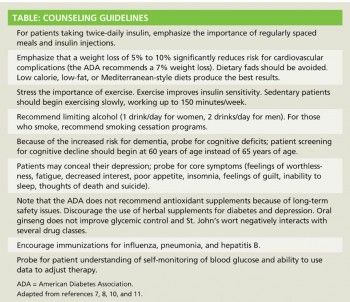Publication
Article
Pharmacy Times
Dangerous Liaisons: Type 2 Diabetes Mellitus and Depression
Author(s):
For patients with type 2 diabetes, depression is not an obvious comorbid condition, but it can lead to serious health complications.

For patients with type 2 diabetes, depression is not an obvious comorbid condition, but it can lead to serious health complications.
Clinical depression’s lifetime prevalence is 17%, affecting 6.7% of adults in a given year. But for the 11.3% of the population who have diabetes mellitus, up to 25% suffer from clinical depression.1,2 Depression’s prevalence is especially high in those with diabetes-related complications.3 The relationship between diabetes and depression is bidirectional—people with depression are at increased risk for developing diabetes and people with diabetes are at increased risk for developing depression.
Mechanisms underlying the bidirectional relationship remain unknown. Depression is associated with decreased physical activity, potentially resulting in unhealthy weight gain—a diabetes risk factor. It is also speculated that depression results in neurohormonal changes, alters glucose transport functions, and increases counterregulatory hormones (cortisol, catecholamines, growth hormone), resulting in insulin resistance and impaired B cell function, which are fundamental changes observed in type 2 diabetes.3,4
Regarding increased risk for depression in those with diabetes, adherence to a diabetes management plan can be challenging. People with diabetes spend up to 2 hours a day managing symptoms and engaging in activities to prevent increased severity, activities that many patients find stressful.4 These stressors are believed to be precursors to clinical depression.5
Diabetes and Depression’s Impact
The impact of comorbid diabetes and depression is severe, resulting in poor glycemic control, increased diabetes complications, and poor adherence to diabetes management—all intensifying disease burden and decreasing quality of life (Sidebar3,5-9).

Diabetes Treatment
Ideally, blood glucose should be maintained at near-normal levels (preprandial levels of 90-130 mg/dL with hemoglobin A1C<6.5% [some organizations use 7% as the cutoff]). Along with a focus on glucose levels, treatment involves multiple interventions for conditions that are associated with diabetes or are consequences of diabetes (ie, elevated lipids, hypertension, neuropathy).10,11 Treatment can be difficult. Data from the National Health and Nutrition Examination Survey indicate that only 40% of cases have optimal glycemic control and up to 20% have poor glycemic control (A1C>9%).12
The American Diabetes Association (ADA) recommends a treatment goal of lowering A1C to below or around 7%. Early initiation of pharmacologic therapy increases the likelihood of optimal glycemic control and reduces long-term complications. Numerous drug classes are available, including biguanides, sulfonylureas, meglitinide derivatives, alpha-glucosidase inhibitors, thiazolidinediones, glucagon-like peptide-1 agonists, dipeptidyl peptidase IV inhibitors, insulins, amylinomimetics, bile acid sequestrants, and dopamine agonists.
Patient characteristics and disease severity guide drug regimens. Treatment protocols generally employ a step-wise approach: diet and exercise at time of diagnosis; if inadequate, then monotherapy (metformin is often the initial agent); followed by dual-drug and triple-drug therapy.10
Treating Depression
Treating depression alone does not necessarily improve glycemic control. It is only 1 of several interventions required for optimal glycemic control (eg, lifestyle changes).8 Pharmacotherapy and evidence-based psychotherapy, especially cognitive behavior therapy, are equally effective in treating depression. Selective serotonin reuptake inhibitors (SSRIs), serotonin norepinephrine reuptake inhibitors, and bupropion are easier to dose and have fewer side effects and drug—drug interactions than older agents such as tricyclic antidepressants or monoamine oxidase inhibitors.8
SSRIs are the most commonly prescribed, partly because they may also facilitate weight loss.4 Many patients require more than 1 treatment trial. Approximately 50% to 70% of patients respond to an initial agent and 50% of nonresponders respond to an alternative agent.8 Because tricyclic antidepressants can cause hyperglycemia and atypical antipsychotics can lead to weight gain, these classes are avoided.4
Counseling Guidelines
Depression is unrecognized and untreated in 50% of individuals with diabetes and depression. Clinical guidelines recommend that patients with diabetes undergo periodic screenings for depression.8 The Table highlights key counseling issues.

Preventing Diabetes
Current guidelines for type 2 diabetes prevention include weight reduction, proper nutrition, exercise, and aggressive treatment of hypertension and dyslipidemia. The Diabetes Prevention Program trial, for example, indicates that modest weight loss (5%) reduces diabetes risk up to 58%.10 Although the FDA has not approved any agent for preventing diabetes, the ADA recommends that metformin should be considered for patients who are obese, younger than 60 years, have impaired fasting glucose and impaired glucose intolerance, and present with other risk factors (eg, family history, hypertension).11
Final Thought
When it comes to diabetes and depression, strict treatment adherence is key— it facilitates improved outcomes and quality of life.
Dr. Zanni is a psychologist and health-systems consultant based in Alexandria, Virginia.
References
1. Pan A, Lucas M, Sun Q, et al. Increased mortality risk in women with depression and diabetes mellitus. Arch Gen Psychiatry. 2011;68:42-50.
2. Nouwen A, Winkley K, Twisk J, et al; European Depression in Diabetes (EDID) Research Consortium. Type 2 diabetes mellitus as a risk factor for the onset of depression: a systematic review and meta-analysis. Diabetologia. 2010;53:2480-2486.
3. Dziemidok P, Makara-Studzińska M, Jarosz MJ. Diabetes and depression: a combination of civilization and life-style diseases is more than simple problem adding - literature review. Ann Agric Environ Med. 2011;18:318-322.
4. Markowitz SM, Gonzalez JS, Wilkinson JL, Safren SA. A review of treating depression in diabetes: emerging findings. Psychosomatics. 2011;52:1-18.
5. Imperatore G, Cadwell BL, Geiss L, et al. Thirty-year trends in cardiovascular risk factor levels among US adults with diabetes: National Health and Nutrition Examination Surveys, 1971-2000. Am J Epidemiol. 2004;160:531-539.
6. Lewko J, Zarzycki W, Krajewska-Kulak E. Relationship between the occurrence of symptoms of anxiety and depression, quality of life, and level of acceptance of illness in patients with type 2 diabetes. Saudi Med J. 2012;33:887-894.
7. Murata P. Dementia risk increased with depression and diabetes. www.medscape.org/viewarticle/755021. Accessed August 15, 2012.
8. Egede L. Treating depression in patients with comorbid diabetes. www.medscape.org/viewarticle/755170. Accessed August 15, 2012.
9. Gebel E. Depression and diabetes. www.forecast.diabetes.org/depression. Accessed August 15, 2012.
10. Khardori R. Type 2 diabetes mellitus. http://emedicine.medscape.com/article/117853-overview. Accessed August 15, 2012.
11. American Diabetes Association. Executive summary: standards of medical care in diabetes--2012. Diabetes Care. 2012;35(suppl 1):S4-S10.
12. Saaddine JB, Cadwell B, Gregg EW, et al. Improvements in diabetes processes of care and intermediate outcomes: United States, 1988-2002. Ann Intern Med. 2006;144:465-474.







